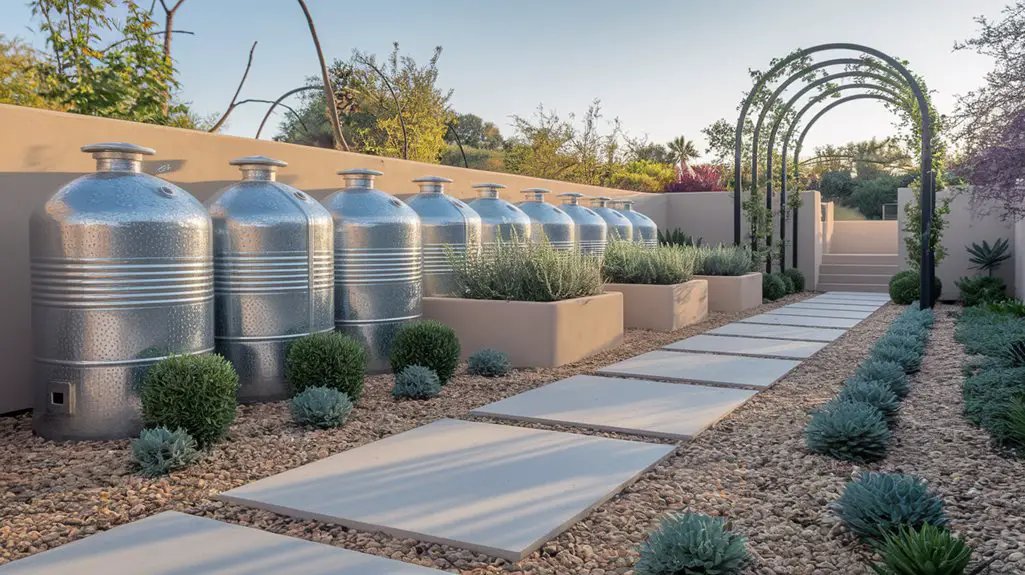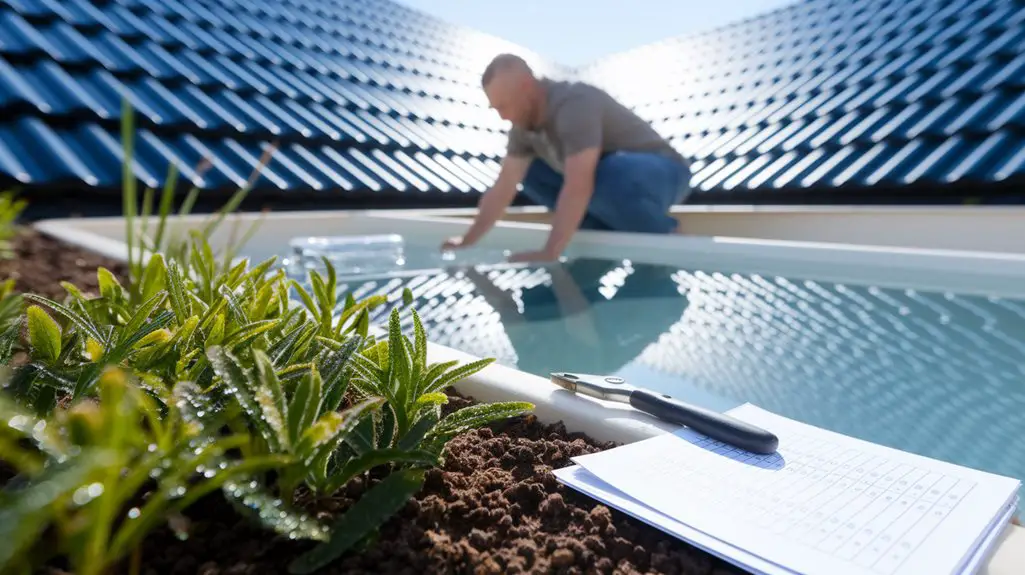You’re facing increasingly unpredictable rainfall patterns, making traditional water management obsolete. A well-designed rainwater harvesting system can be your lifeline during extended dry spells, but most setups fail when drought conditions intensify. By implementing seven strategic modifications to your collection infrastructure, you’ll create a system that thrives even when rain becomes scarce. These practical enhancements don’t just conserve water—they transform your property into a self-sustaining ecosystem that weathers the driest seasons.
Selecting the Right Size Storage Tanks for Dry Periods
Three critical factors determine the appropriate size for your drought-resistant rainwater storage tanks: local rainfall patterns, household water needs, and available installation space.
You’ll need to analyze historical precipitation data, focusing on dry season duration and intensity to calculate minimum capacity requirements.
For residential systems, start by tracking your daily water consumption. Multiply this by your region’s longest drought period (typically 30-90 days) to establish baseline capacity needs.
Most households require 1,500-5,000 gallons to withstand extended dry spells.
Consider vertical tanks for limited spaces, or interconnected smaller units if you can’t accommodate a single large container.
Materials matter too—polyethylene offers affordability, while stainless steel provides durability for extreme conditions.
Always factor in 20% additional capacity for unexpected drought extensions.
Installing Efficient Multi-Surface Collection Systems

While traditional rainwater harvesting typically relies on rooftop collection alone, efficient multi-surface systems dramatically increase your water capture potential by incorporating various catchment areas throughout your property. You’ll need specialized guttering, filters, and piping to connect these diverse surfaces to your storage system. Additionally, utilizing rainwater collection barrels can enhance your overall efficiency by providing a convenient storage solution.
| Surface Type | Collection Efficiency | Best Applications |
|---|---|---|
| Metal Roofing | 95% | Primary collection |
| Concrete Patios | 70-80% | Supplemental capture |
| Driveways | 60-70% | Large-volume potential |
| Artificial Turf | 50-60% | Recreational areas |
Install first-flush diverters on each collection surface to prevent contaminants from entering your storage tanks. Position micro-basins strategically to direct runoff toward collection points. You’ll maximize capture by ensuring all surfaces have a minimum 2% slope toward collection channels, eliminating pooling and wastage.
Implementing Smart Filtration for Cleaner Water Storage

Smart filtration serves as the critical bridge between collection and storage in drought-resistant rainwater systems, guaranteeing your harvested water remains contaminant-free and usable for multiple applications.
Start with a first-flush diverter to eliminate initial runoff containing the highest concentration of pollutants. Then, incorporate a two-stage filtration process: first using a mesh screen (250-500 microns) to capture leaves and debris, followed by a finer filter (20-50 microns) for smaller particulates.
For advanced purification, consider adding activated carbon filters to remove chemical contaminants and UV sterilization for pathogen elimination.
Install pressure gauges before and after filters to monitor clogging. You’ll need to clean or replace primary filters seasonally, while secondary filters typically require attention annually.
This maintenance schedule guarantees ideal flow rates and extends your system’s overall efficiency.
Creating Strategic Overflow Management During Heavy Rains
Strategic overflow management represents the often-overlooked insurance policy for your drought-resistant rainwater system. When heavy rains test your system’s capacity, proper overflow routing protects your foundation while directing excess water to beneficial uses. Implementing eco-friendly rainwater harvesting techniques can enhance the efficiency of these overflow strategies.
| Overflow Strategy | Application |
|---|---|
| French drains | Gradual ground infiltration |
| Rain gardens | Biodiversity support zones |
| Secondary tanks | Extended storage capacity |
| Swales | Landscape-integrated flow paths |
| Municipal diversion | Responsible excess management |
You’ll need to position overflow pipes at least 10 feet from your foundation and slope them at a 2% grade minimum. Install debris guards at all discharge points to prevent clogging during storms. Consider automated valves that can redirect overflow to secondary collection zones when your primary system reaches capacity—transforming potential problems into additional water security during drought periods.
Designing Low-Maintenance Distribution Networks
Once properly collected, even the most abundant rainwater becomes useless without an efficient distribution network to deliver it where needed.
Design your system with gravity-fed distribution whenever possible, minimizing electrical pumps and reducing both energy consumption and maintenance.
For truly low-maintenance distribution networks, focus on these key elements:
- Use food-grade polyethylene piping with UV protection that won’t degrade, leach chemicals, or require frequent replacement even when exposed to elements.
- Install cleanout ports at strategic junction points to allow for periodic flushing of sediment without dismantling the system.
- Incorporate pressure-compensating drip emitters rather than spray heads to guarantee consistent flow rates regardless of elevation changes while preventing clogging.
Add mesh filters at distribution points to catch any remaining particulates before final delivery. Additionally, consider implementing rainwater harvesting systems to enhance your overall water management strategy.
Incorporating Drought-Tolerant Landscaping With Rainwater Systems
Combining drought-tolerant landscaping with rainwater harvesting creates a synergistic system that maximizes water efficiency while minimizing environmental impact.
Select native plants with deep root systems that require minimal irrigation once established. Group plants with similar water needs together—a practice called hydrozoning—to prevent overwatering.
Design your landscape with rain gardens or bioswales that direct harvested water to planted areas while preventing runoff.
Install drip irrigation connected to your rainwater tanks to deliver water precisely where it’s needed, reducing waste by up to 60% compared to conventional sprinklers.
Use permeable hardscaping and mulch to increase water infiltration and reduce evaporation.
Consider installing smart controllers that adjust irrigation schedules based on soil moisture and weather forecasts, ensuring you’re only using collected rainwater when absolutely necessary. Additionally, implementing maximum efficiency rainwater systems can further enhance your water conservation efforts.
Automating Your System With Conservation-Minded Controls
Why settle for manual rainwater management when smart technology can maximize every drop?
Today’s conservation-minded control systems integrate seamlessly with your rainwater harvesting setup, offering precision that manual systems simply can’t match.
- Soil moisture sensors – Install these in key garden zones to trigger irrigation only when soil conditions demand it, preventing overwatering even after rainfall.
- Smart controllers with weather forecasting capabilities – These adjust collection and distribution based on predicted rainfall, optimizing storage capacity.
- Flow meters – Monitor water usage in real-time through smartphone apps, helping you identify waste and adjust your system accordingly.
These automation tools not only conserve precious water resources but also save you time and reduce your environmental footprint during drought conditions. Furthermore, incorporating effective rainwater filtration solutions can enhance the quality of the water collected, ensuring it is safe for various household uses.
Conclusion
By implementing these seven strategies, you’re building resilience into your home’s water system. Like the baobab tree that stores thousands of gallons in its trunk during rainy seasons, your optimized rainwater system creates abundance during scarcity. With climate models projecting 20-30% rainfall reduction in many regions by 2050, your sustainable water infrastructure isn’t just convenient—it’s essential preparation for our changing planet.



